As the world becomes more connected than ever before, access to international goods and services is even more accessible than in the past. The use of air cargo and air freight trade agreements can be established across different countries as a way to transport goods all over the globe. Statistics have shown that countries with only 1% better air cargo connectivity engage more in more than 6% of trade. Airfreight or air cargo can be used both in a commercial sense and in a capacity, and both terms are often used interchangeably when speaking about shipping by air. The importance of shipping by air is shown by the reliance that is placed on it when it comes to importing and exporting goods.
What are airfreight and air cargo?
Airfreight refers to products that are moved and imported on a commercial air carrier or charter. Typically used by logistics companies, air shipping is used to import products in bulk for both individuals and organisations. Freight forwarding companies facilitate the use of airfreight and are essentially the middle man when getting the goods from one location to another. There are many commercial airlines that are used for air shipping, including British Airways PLC and West Atlantic PLC.

(Image Source: Statista)
Although the terms air cargo and airfreight can be used interchangeably, air cargo is often referred to when cargo is simply added onto an existing air carrier’s cargo capacity rather than on a private charter. Businesses that don’t own their own planes or aircraft, can either lease or purchase second-hand air carriers as a way to import and export their own goods in an international fashion.
Over the last fifty years alone, air freight and air cargo have become the desired method of transporting goods across both local and international borders. With the constant development and maintenance of air carriers, the logistics and possibilities of transporting goods are becoming ever more efficient and allow access to an endless amount of products and goods.
The History of Air Cargo
The first cargo flight was orchestrated in 1910 and was a very different build to what we see in air cargo charters today. A common cargo air charter was 747 Freighter which was a prominent aircraft in the ’70s and has now evolved into using the Airbus A350.
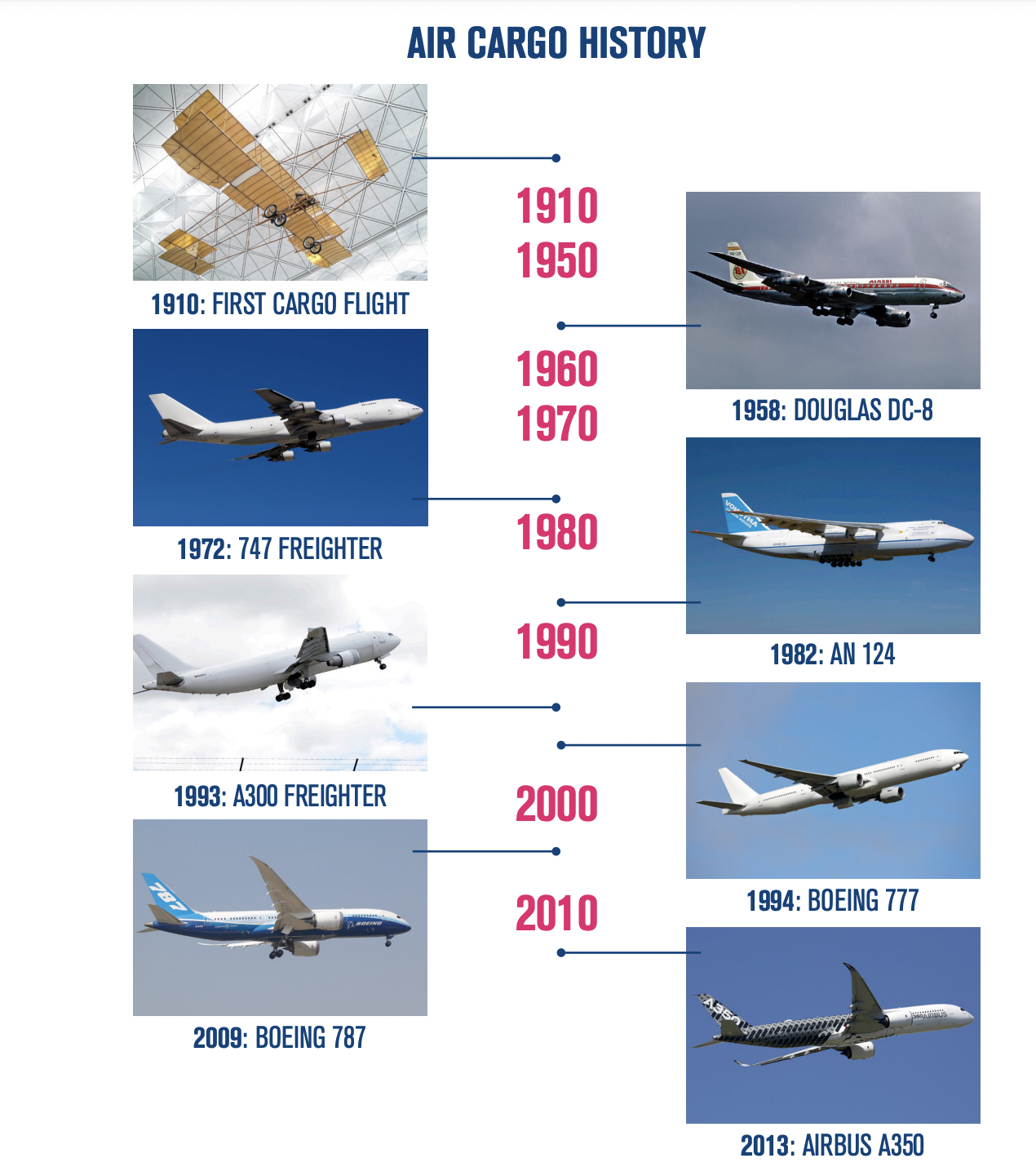
(Image Source: IATA)
The amount of cargo and freight weight has increased over the years so naturally so would the aircraft have evolved to meet those needs. The demand for air freight has significantly increased and the demand on what types of aircraft to use has been a catalyst for what features to use.
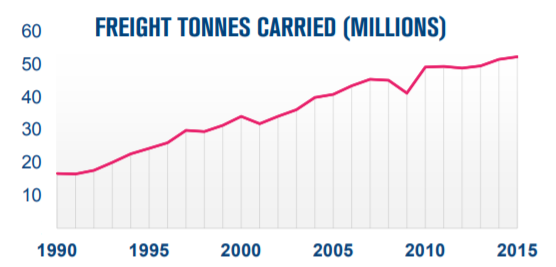
(Image Source: IATA)
As the data above from IATA’s brochure on the value of air cargo shows, the freight tonnes carried by aircraft have tripled since 1990, with the total mass nearly doubling in the 21st Century alone.
Speed is the Name of the Game
When it comes to the operations side of air cargo and air freight, goods that are time-sensitive in terms of delivery have to be shipped in an extremely organised fashion. The way in which they are received has to be timely in order to ensure the best product for consumption or use. For example, with imported dairy products or fresh fruits and vegetables, time is of the essence.
As the demands for certain products, such as avocados and figs have drastically increased, so has the need for air shipping. There are challenges when it comes to delivering fresh goods, and air freight is very much a solution. Rest assured, these goods can be delivered without the worry of spoilage which may be seen more commonly with other means of transportation.
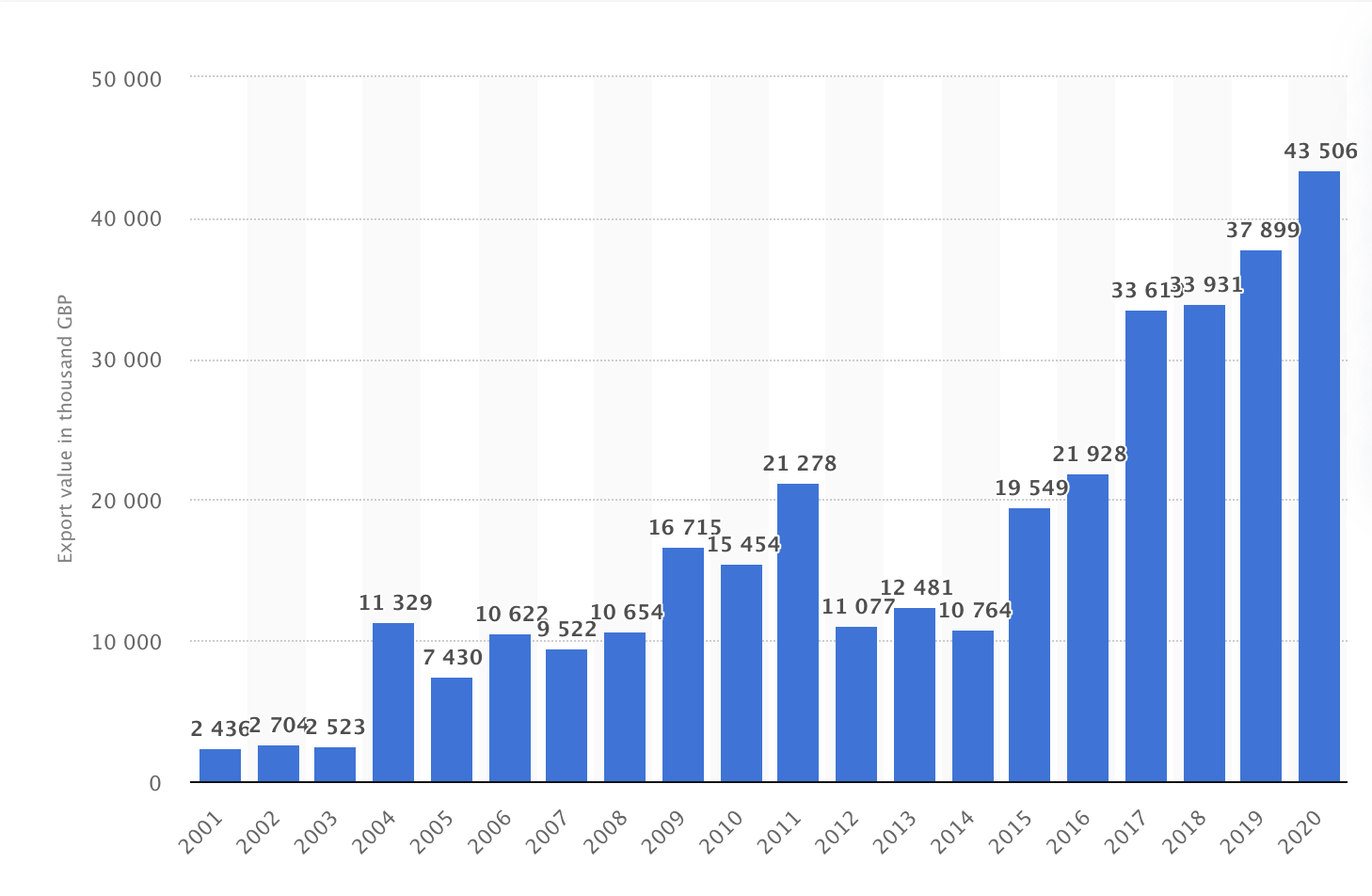
(Image Source: Statista)
How Does Air Freight Work?
The possibilities of what can be delivered, imported and exported are virtually endless when it comes to air cargo and air freight. From car parts and military equipment to medical supplies and consumables, there are different sets of operations and types of air carriers that are more fitting to particular goods than others. The constant technological development of aircraft means that the range of goods that can be moved is becoming more and more diverse.
There are typically three categories of air freight that can be used when it comes to air freight:
- Passenger airline
- Cargo-only plane
- Supercargo plane that is specifically for heavy items
Delivery via passenger airline is essentially the use of an existing commercial airline to transport goods. As it is a commercial airline, the airlines themselves can earn a significant amount by offering some of their cargo space. Smaller packages and imports can be placed in the belly of a commercial flight and transported along with other goods. There is still a good and plentiful weight offering when choosing commercial airlines to move cargo, but heavier and bulkier moving may not always be the best choice. The load is stored in the belly of the plane and is in a separate storage area from the passenger’s luggage which is stored above any cargo in a commercial aircraft. This type of space can even be used to transport s the bodies of the deceased without the living passengers knowing about it!
A cargo-only plane or a freight plane can carry substantially more than a commercial charter.
The capacity of a cargo-only vessel or air freight can carry up to 736 cubic meters of goods – this is over 8000 full 20-gallon gas tanks. One of the largest planes that are often used for this very purpose is the Boeing 747 and can carry around 30 large pallets of cargo. This type of plane is often used for transporting animals like horses and livestock. As a way to keep this kind of stock stable, specialist containers are used to keep animals stable. This is also a technique used for products that are irregularly shaped and extremely large-sized products. The cargo deck is a primary deck for shipping and is often used by delivery companies such as FedEx and UPS. When loading a freight plane, using electric rollers allows the cargo floor to be utilised in a more structured way than with forklifts, which sometimes cannot fit onto the cargo space. With the pallets being manoeuvred whilst on the plane itself, the use of electric rollers is of great assistance when moving the cargo around.

(Image Source: aircargonews)
Super transporters or supercargo planes do exactly what they say on the tin. These types of jumbo charters are used to transport goods and cargo that are large and often heavy in weight.
The features of the plane itself match the requirements of the aircraft, for example, large doors and a capacity that can hold approximately 250 tonnes of weight. The cargo within such a large space is often stacked where possible and is loaded as near to the aircraft as possible. In order to encourage a direct procedure with larger cargo, a nearby transporter is used and loaded onto the plane at the terminal.
How is Air Freight and Cargo Calculated?
As the import and export of goods via air is to be an efficient method, the calculations and preparation to carry cargo have to be accurate. A charter’s capacity will very much dictate how much cargo it can hold and carry. There are equations to make sure that this is correct.
Taking into account, the amount of product and the type of carrier or aircraft used can impact the rate of shipping. This is known as the chargeable weight. A typical kilogram of shipping internationally can range from $2.00 to more than $100.00 depending on the factors that are considered. The chargeable weight is the gross weight or weight in volume (depending on which is higher). Volumetric weight is calculated by using an equation that takes into account the length x width x height and the weight of cargo. Just because a product is larger, does not necessarily mean that it will weigh more than smaller products yet take up more space. Hence, the chargeable weight is whichever is greater. In general, volumetric weight is calculated at 6000 cubic centimetres for every kilogram. These factors will impact the cost and weight is more often than not used rather than volume.
The rates of carrying air freight fluctuate and is based on an extremely flexible pricing policy. Taking into account the economic climate and the demand for the products at the time of shipping are all taken into account and then proceed accordingly. The conditions of the economy directly affect imports and exports, no matter what the industry. When a charter has space to spare, costs of shipping will be lowered as a way of encouraging it to be filled and navigate the economic climate at the same time.
Paired with the financial conditions that surround importing and exporting, so do social factors. Conditions such as world strikes and, as the last year have shown, pandemics can make it a more costly affair when choosing to transport cargo by flight.
Alongside the cost of shipping the cargo itself, the working expenses is something that is calculated when it comes to pricing up air freight. Working expenses include operational costs, such as fuel costs at the time and stopping expenses. With more and more customers reading into and actioning conscious consumerism the environmental issues when it comes to air shipping and cargo must also be taken into account as a way to make each charter trip as efficient as possible when it comes to planes, importing and exporting.
What are the Advantages of Air Freight?
Businesses and companies often turn to air freight or air cargo as a means to import and export their goods and with good reason. Companies such as DHL and Hellman’s make use of air freight as their method of shipping. IATA’s research into the value of air cargo shows that 7.4 billion postal parcels are sent every year, illustrating the value of the service to us as consumers. The efficiency that comes with choosing this as a shipping method is often a primary reason that it is selected. It is quick, particularly if a direct service is used. Imports and exports can be actioned and received sometimes within the same day or after a couple of days when using air cargo or air freight.
When calculating the costable charge for goods, it is the weight that is taken into account rather than the volume metric for them. This means better value for money, especially when transporting smaller deliveries. This cost vs efficiency method of shipping is a massive plus to choosing air freight and a big reason why it is often done.
The range of delivery styles can suit the needs of many businesses that chose air shipping and their method of importing or exporting. From selecting how your delivery will be received to whether or not you would like a direct delivery, the options make it easier for air freight to be navigated for specific needs.
Because of the methods of packaging and storage, with the crates and handling, air freight can ship an array of goods, including fragile and valuable products. This, in turn, lowers the risk of damage to the goods and will ensure the safe delivery of products.
The security of air freight and air cargo is extremely high and the availability of tracked packages means that being updated with the status of a delivery is easy and can be relayed to users of air shipping.
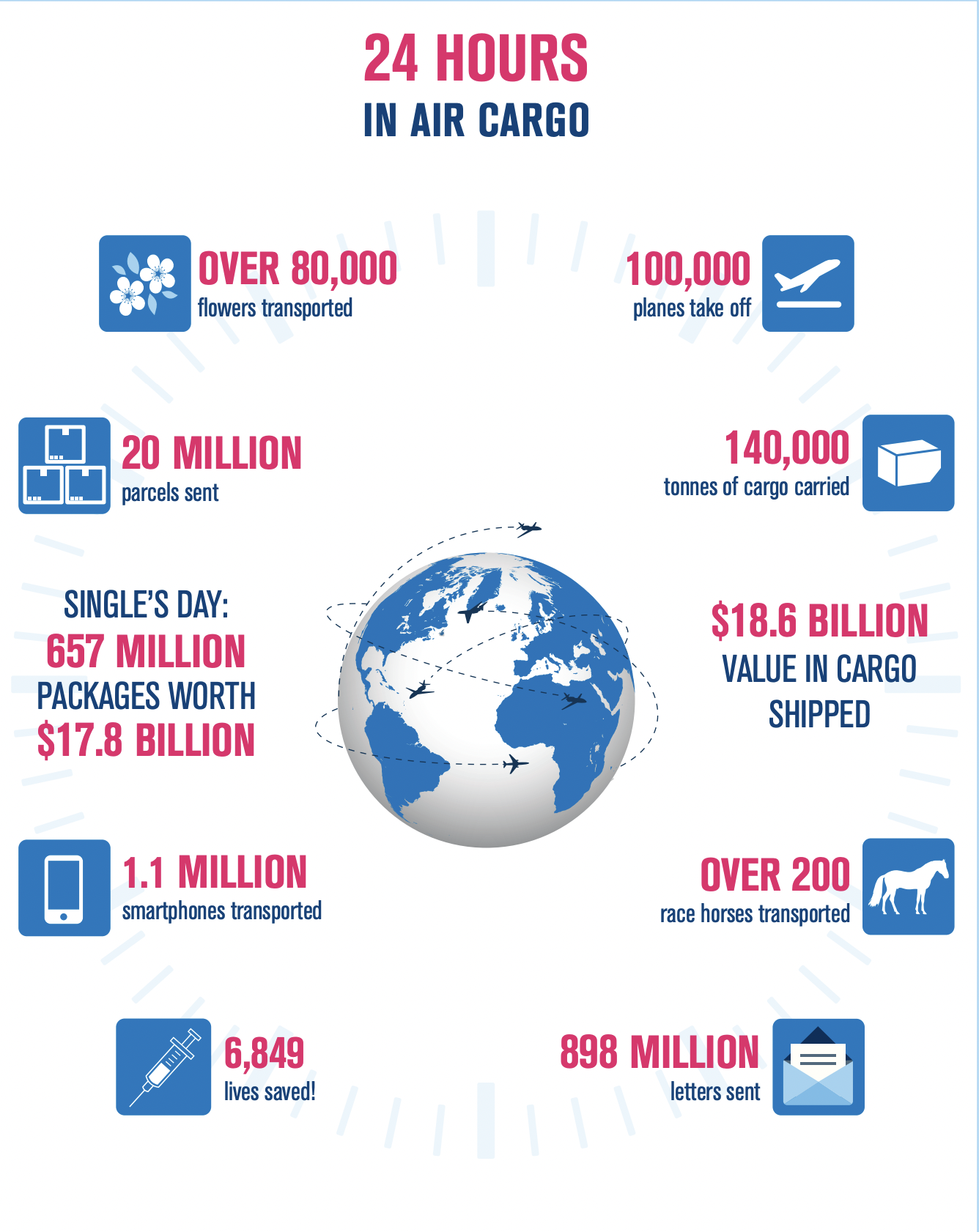
(Image Source: IATA)
What are the Disadvantages of Air Freight?
Although air freight bears many advantages, just like with any alternative method of transportation, there are downfalls to selecting this way of shipping goods and products.
Comparable to sea freight, air shipping can be more expensive. Not only for the shipping itself but for the taxes that come with air freight. For example, the costs of the goods themselves.
If you are using air cargo that is utilising a commercial charter, you will have little control over the schedule of the aircraft and time for your goods to be imported or exported. With these types of flights, they often wait until the cargo belly is full before making any trips. Alongside this, organising your shipments over what location the aircraft is landing in that week may also be an annoyance. Sometimes an aircraft may only be landing in a certain location, so planning accordingly would be a must when choosing air freight.
Just as you would expect with commercial flying, there are also restrictions on the goods that can be shipped using an aircraft. Being very strict about it means that there may be limits over what can be exported based on the nature of your business. For example, gas and fuel and strong magnets cannot be imported and exported in this manner.
The impact on the environment is a disadvantage to using air freight as the greenhouse gases and emissions that come from this mode of transport. This is being looked into and therefore initiatives like considering using sustainable fuel have been started.
What are the Logistics of Air Freight?
When it comes to understanding the process of air freight, it starts at the source. This is the demand for a product and placing an order accordingly. As a business or a manufacturer, you can decide, taking into account cost and time, whether or not air freight is for you and then once you have decided you can begin the process.
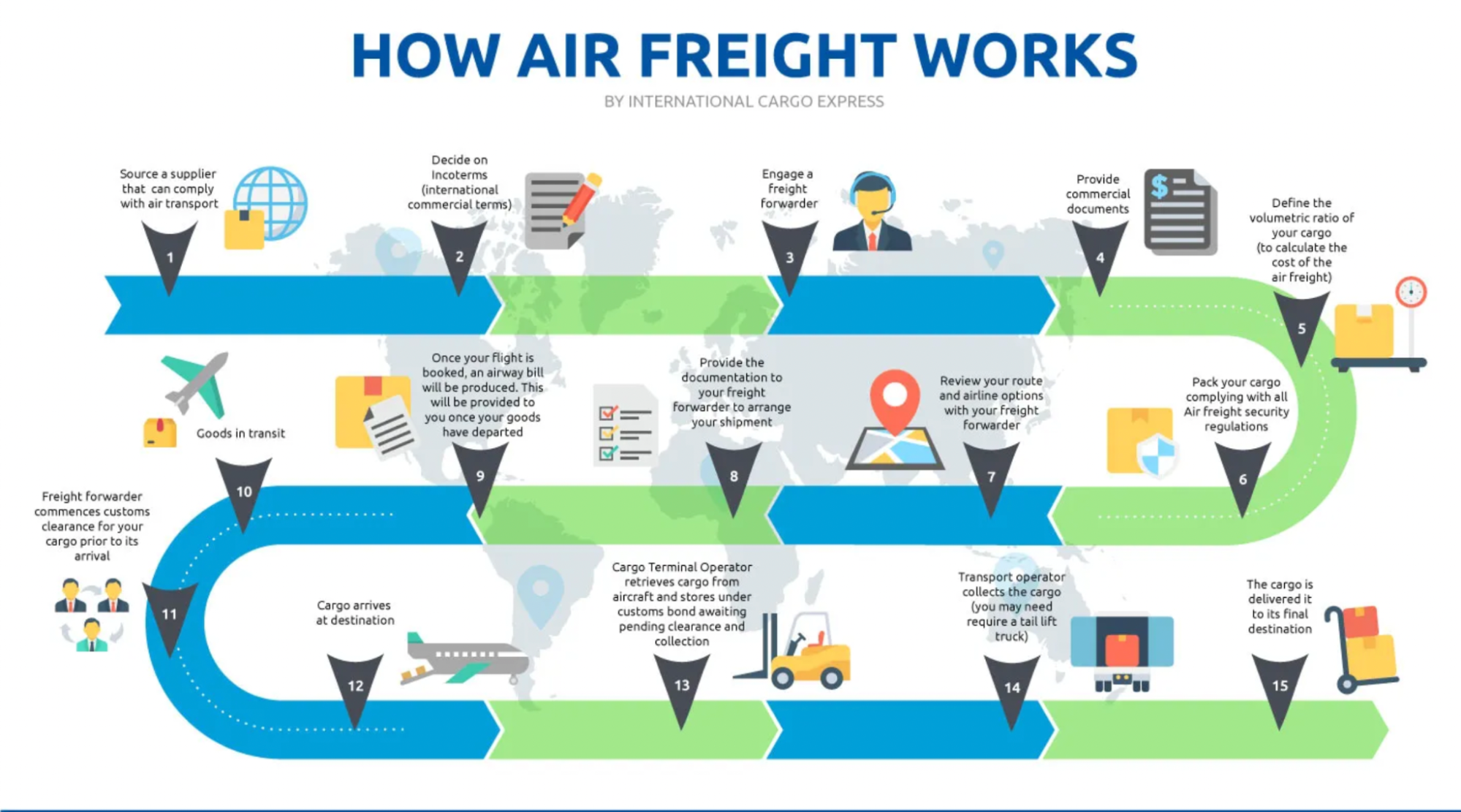
(Image Source: Ice Cargo)
Step One: Placing an Order
First of all, a quote and a product order must be placed. When it comes to importing and exporting, it’s a two-way street. There is then research done to ensure that the desired supplier actually works parallel with the method of the charter that wants to be used. For example, if a business or organisation wants to order from a supplier and the commercial airline that is planned to be used does not operate with that supplier, then a new plan must be made. This is the stage where you need to truly evaluate air freight and if it is the right decision to be made.
Step Two: Pricing Up
Second to evaluating if you want to use air freight, is then having a sound understanding of the impact of air freight. Before you enter into any contract, you need to ensure you understand the operation side of the transport. Ensuring you understand how volumetric ratios work and how you are being charged based on weight is important as well as understanding the types of containers that will be used for your cargo. This is to ensure that your goods and transport meet the air freight security regulations and further cement why you are choosing this method of importing and exporting.
Step Three: Loading Your Cargo
Thirdly, is finally packing your cargo and booking your freight. This is the stage in the air freight process when you can speak to a forwarder about any restrictions applied to your cargo, compare and decide what service you would like to use and decide what route you would like your goods to take. If the goods will not last or are perishable, then choosing a direct route will be more beneficial.
A freight forwarder is essentially a middle man for the shipping of your goods and will oversee the arrangement for your shipping. They will be responsible for preparing the correct documentation for the county from which you’re exporting goods from or importing goods to.
For example, when importing into Australia you will need to make sure you have a commercial invoice, a packing list, a certificate of origin for your goods, import permits, manufacturers declarations and declaration of any dangerous goods. Although your supplier will need to prepare all these documents for your flight forwarder, it is your responsibility to ensure everything is in order to make your air freight experience run as smoothly as possible. Your cargo at this stage will then be loaded onto the flight that has been booked as your designated service will be ready to get your goods to where they need to be.
Step Four: Passing Checks
Once your cargo has passed all the checks and all of the documentation has been provided, the next step in the air freight process is to have your goods processed through export customs and placed into transit. On arrival, your cargo will still have to go through checks for the country that it is being imported into. Getting clearance on these products will be a result of vigilant checks and further paperwork. To ensure there are no hiccups at this stage, it is important to thoroughly check the customs policy for the country or destination for which goods are being imported.
Once the goods have passed the check, it is time for them to leave the airport and the charter itself. This is when a transport operator will collect the cargo and goods and load it onto what will most likely be a large lorry and deliver it to a final destination. As a user of air freight, it would be helpful and useful to know where the transport operator will be loading and this information will be sent to you by your freight forwarder. Your freight forwarder is your main point of contact when it regards your goods right up until the point of being delivered to the final location after which you can opt to track.
Supporting the Rise of eCommerce
The total value of global eCommerce has been forecasted to reach $4.8 trillion in 2021. Such astronomical numbers call for an efficient and comprehensive solution to satisfy the needs of consumers.
The global scale of the internet means that online retailing can surpass the performance of brick and mortar competitors worldwide. To deliver to their customers, eCommerce firms have an array of options at their disposal already. They can choose surface transport in the form of road, rail and sea – or they can opt for air transport.
As eCommerce beyond borders continues to grow in popularity, and international sales become more commonplace, air cargo is well-placed to serve the needs of retail stores and deliver their goods globally in a quick, efficient, and reliable manner.
Logistics by air are provided by the traditional model in terms of freight forwarders, ground handlers and airlines. Integrators and postal operators also work to ensure a smooth and effective service from order to delivery.
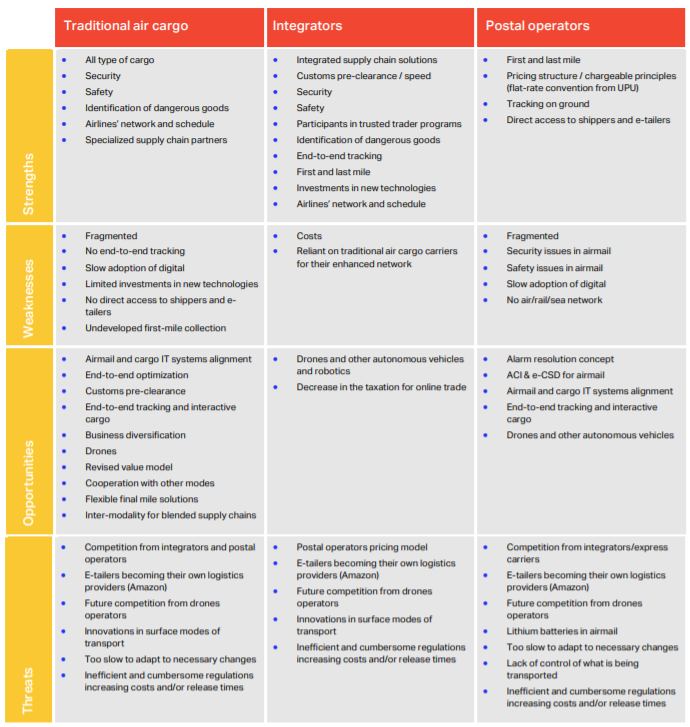
(Image Source: IATA)
As we can see from IATA’s white paper on Air Cargo and eCommerce Enabling Global Trade, we can see that the security and safety offered by the service can be far greater than alternative modes of transport, while end-to-end optimization and tracking can offer significant opportunities for future growth.
However, the white paper also concedes that a lack of digital adoption and limited investments in new technology is hindering the development of the service – although there’s plenty of room for the adoption of digital transformation technologies across the industry in the coming years.
Airfreight vs Sea Shipping
Airfreight most certainly has its benefits, as does sea freight. There are key differences between both methods of shipping, and the first is of course the time it takes to transport your goods. A key reason that air freight is used is because of the directive nature of the charter and route, however, this is also very much dependent on the type of cargo that you are wanting to move. For the cargo that is restricted from being transported via air freight, sea shipping of course would be the most ideal option.
The cost of sea shipping may also differ from air charter as the pricing strategy may be somewhat different. Sea shipping is often used when there is no immediate urgency for a product or if there is toxic waste being transported.
The security of the cargo is also somewhat more protected when deciding to import and export via air as the measures are more strict than when choosing to ship by sea. As one of the primary stages of air freight is keeping tabs on your goods and ensuring that they are where they are meant to be at the estimated time is something that can be monitored with your freight forwarder. This, in turn, makes tracking your goods a more streamlined process and having a point of call on the status of your transit and goods delivery.
When it comes to the basics of air freight, having an understanding of the process will ensure that each requirement is met when it comes to wanting to export products. As so many of our daily items are imported via air cargo, having an understanding of this industry will be beneficial to have an awareness of the process that demand creates with regards to shipping. There are both advantages and disadvantages to this method of shipping so having an understanding may perhaps factor into consumer consideration in the future.








